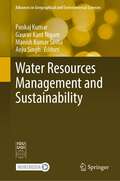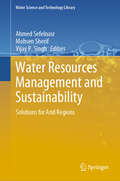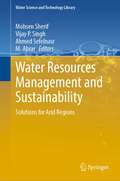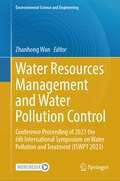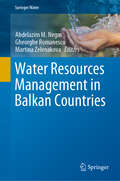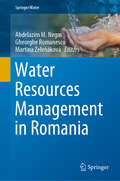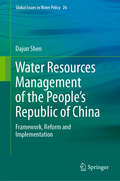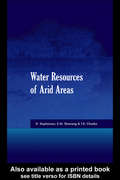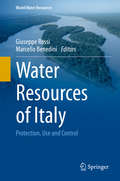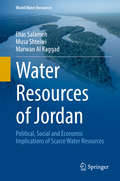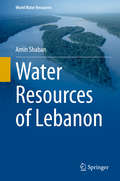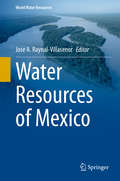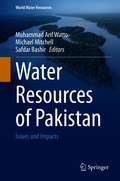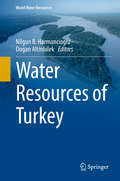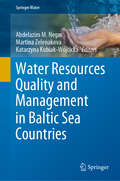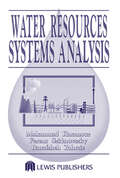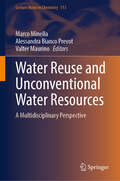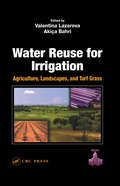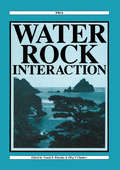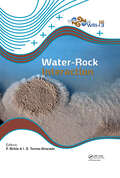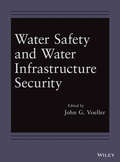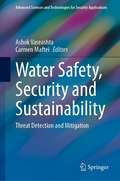- Table View
- List View
Water Resources Management and Sustainability (Advances in Geographical and Environmental Sciences)
by Pankaj Kumar Anju Singh Gaurav Kant Nigam Manish Kumar SinhaWater is the elixir of life and is crucial for sustainable development. Earlier, it was considered to be a limitless or at least a fully renewable natural resource. During the past 20 years, however, there has been tremendous pressure on this precious natural resource mainly due to rapid urbanization, industrialization and the increase in the human population. Together, these have resulted in increasing demand for irrigation, industrial, and household purposes to meet supply-chain requirements. Keeping in mind the scarcity of available water resources in the near future and its impending threats, it has become imperative on the part of scientists in hydrology and allied disciplines such as geography, landscape planning, sustainability science etc. Regional planners and supply chain management experts also must be involved in studying the spatial and temporal nature of the growing demand for water and the future availability for its judicial use and sustainable management. A primary intent of the book is to provide comprehensive scientific knowledge base on water resource management and sustainability. It covers geo-engineering and scientific problems, case studies, and sustainable solutions in the water resources management domain. Additionally and of equal importance, the chapters of the book provide in-depth coverage on water resource vulnerability, water quality, wastewater treatment, application of remote sensing and geographical information systems hydrological modeling and harvesting, climate variability and runoff, sediment discharge and irrigation planning, community participation in water governance, internet of things and machine learning applications for sustainable water resources management. This practical, state-of-the-art reference book is a valuable resource for students, researchers, scientists, policymakers, spatio-temporal designers of water resource systems, various stake holders interested in hydro-climatology and sustainable water resources management.
Water Resources Management and Sustainability: Solutions for Arid Regions (Water Science and Technology Library #114)
by Ahmed Sefelnasr Mohsen Sherif Vijay P. SinghThe first section deals with hydrological topics, problems, and principles. In this chapter, detailed studies related to hydrological monitoring are carried out. Overland flow velocity estimation, wireless sensor networks, and application of deep learning techniques are discussed. These topics are helpful to estimate overland flow velocities using tracer techniques based on the infrared thermography and fluorescent properties of quinine which can help in the visualization of shallow flows, evaluation of high-resolution rainfall measurement, and extracting water bodies from high-resolution drones and satellite imagery using an integrated deep learning method. The chapter critically discusses the advantage of thermal tracers, utilizing the wireless sensor networks for the accurate capture of spatially varied precipitation patterns, and evaluation and quality assessment of water extraction using deep learning techniques. It highlights recommendations and limitations that should be taken into account for hydrological monitoring. Moreover, this section discusses rainfall and floods and their related attributes in arid regions, including flood mitigation and risk assessment. Flood mapping and assessment, recent trends of floods and their impacts are comprehensively discussed. The outcomes are for useful hydrologic infrastructure design under changing climate. This part also highlights the importance of applying new methodologies, considering the statements and questions asked by scientists and researchers. The second section addresses droughts and their analysis and assessment. Drought events are great challenges faced by nature in the wake of climate change. This part will help stakeholders gather useful information and develop a deep understanding of these salient features of climate change's impacts. It deals with the various studies conducted in the field of drought and flash drought. Flash drought is a composition of various factors leading to intense drought conditions. So, limitations and recommendations to mitigate drought events are discussed in detail. The third section discusses groundwater as an important component in the water budget in arid regions. Threats, recharges, quality, and management options of this resource are also discussed. Beginning with a perspective on the management of this resource, the papers go on to discuss rational decision making, challenges, use of information technology, integrated management, and modeling for groundwater resources management. Section four deals with water quality. This part discusses modern techniques for water quality assessment and treatment procedures. The industrial and commercial area generates a large amount of waste which is indiscriminately disposed of. leading to several environmental issues. This section provides a detailed analysis on water quality, hydrogeochemistry, impact and benefits of treating municipal wastewater to tertiary quality, groundwater table and quality deterioration. Recommendations for adequate planning, design, construction, and location of open dumpsites to ameliorate groundwater pollution, and the closing of trace metal boreholes to avoid possible health implications or outbreaks that are likely occurring or are expected to occur. Section five discusses water resources management. This topic has been receiving a fair amount of attention in many arid countries of the world and more specifically in the Gulf region. This section addresses regulations for conservation, reuse, and security. The limited freshwater resources must be developed, managed, and used as efficiently as possible. Decision support systems for water resources planning, management, and water rights analyses and control have been discussed as well.
Water Resources Management and Sustainability: Solutions for Arid Regions (Water Science and Technology Library #121)
by Mohsen Sherif Vijay P. Singh Ahmed Sefelnasr M. AbrarThe book will be of interest to researchers and practitioners in the field of hydrology, environmental engineering, agricultural engineering, earth sciences, and watershed and range sciences, as well as to those engaged in water resources planning, development and management in arid and semi-arid areas. Given the lack of literature on arid regions, this book not only provides an assessment of water resource management in arid regions but also addresses solutions, and it can also be an outstanding textbook on water resources management and sustainability for arid regions.This volume in the Water Science and Technology Library includes selected papers that have been presented and discussed during the International Water Resources Management and Sustainability: Solutions for Arid Regions, 22–-24 March 2022, Dubai, United Arab Emirates. The conference was organized by the National Water and Energy Center, UAE University, in collaboration with the South Australian Goyder Institute for Water Research, and the Department for Environment and Water, Government of South Australia. The conference attracted a large number of nationally and internationally well-known experts who have been at the forefront of water resources management and sustainability in arid and semi-arid regions. More than 55 countries, covering the five continents, were represented. The conference was designed to facilitate and encourage new perspectives on how science and innovative technologies can transform water management and sustainability in arid and semi-arid regions around the world. It addressed current challenges and priorities in water management and provided a forum to share knowledge, experiences, research, and discoveries.
Water Resources Management and Water Pollution Control: Conference Proceeding of 2023 the 6th International Symposium on Water Pollution and Treatment (ISWPT 2023) (Environmental Science and Engineering)
by Zhanhong WanThis book features select peer-reviewed proceedings from the 6th International Symposium on Water Pollution and Treatment (ISWPT 2023). It comprises articles written by researchers, practitioners, policymakers and entrepreneurs that examine recent advancements in water pollution and treatment. The book covers a range of topics, including the impact of climate change on water pollution and technologies for reducing greenhouse emissions in water and wastewater treatment. Additionally, it explores water resources planning and management, water quality protection and technologies and processes that control water pollution. This book is useful for beginners, researchers and professionals working in the area of water pollution management, policy and governance.
Water Resources Management in Balkan Countries (Springer Water)
by Gheorghe Romanescu Abdelazim M. Negm Martina ZelenakovaThis book presents an overview and knowledgeable on water resources management in Balkan countries – Slovenia, North Macedonia, Serbia, Croatia, Greece, and Bulgaria.The book shows the state of the art and also the latest research findings of the different aspects of water resources management in Balkan countries with case studies that reveal the best practice in water resources management, development, and protection. Researchers and scientists from the Balkan countries present their experiences and expertise on a wide range of water resources topics.Therefore, the book is of particular interest to decisions planners/makers and stakeholders. Also, the book will be useful to experts, professionals, researchers, scientists, practitioners, academics working in the field of water resources management in Balkan countries and analogous regions.
Water Resources Management in Romania (Springer Water)
by Abdelazim M. Negm Gheorghe Romanescu Martina ZeleňákováThis book discusses water resources management in Romania from a hydrological perspective, presenting the latest research developments and state-of-the-art knowledge that can be applied to efficiently solve a variety of problems in integrated water resources management. It focuses on a wide range of water resources issues – from hydrology and water quantity, quality and supply to flood protection, hydrological hazards and ecosystems, and includes case studies from various watersheds in Romania. As such, the book appeals to researchers, practitioners and graduates as well as to anybody interested in water resources management.
Water Resources Management of the People’s Republic of China: Framework, Reform and Implementation (Global Issues in Water Policy #26)
by Dajun ShenThis book explores water resources management issues in China and possible solutions. It analyzes a wide range of general and specific topics, providing case studies and a balanced review of the past and present situation as well as future developments. The book begins with a general introduction and an overview of hydrology, water resources, and development issues in China. It then presents a management framework, including a management system, management institutions, river basin management, water pricing, water rights, and groundwater management, and discusses its implementation, covering water resources allocation and regulation in the Yellow River, integrated water affair management reforms, and agricultural water management in northern China. The last section focuses on the current reforms and hot topics, with strong emphasis on stringent water resource strategies applied to the river and lake principle system, recycled water use and water resources asset management, as well as climate change impacts, and concludes with a summary of the many changes in the water sector in China and a look at the road ahead and the areas that still need to be reformed.
Water Resources of Arid Areas: Proceedings of the International Conference on Water Resources of Arid and Semi-Arid Regions of Africa, Gaborone, Botswana, 3-6 August 2004
by D. Stephenson E. M. Shemang T. R. ChaokaWith Africa's water resources constantly threatened by an increasing population and the resultant rise in water demand, together with the stresses of water use for various activities, desertification, climate change, and other interventions in the water cycle by man, it is vital that the water resources in arid and semi-arid regions are developed a
Water Resources of Italy: Protection, Use and Control (World Water Resources #5)
by Marcello Benedini Giuseppe RossiThis book offers a comprehensive framework of the current state of water resources in Italy and of the main stages of the evolutionary way in the last decades for achieving an integrated, sustainable and equitable water resources management. The main paradigms of water resources development are identified as: i) engineering and economic approach to water resources exploitation, ii) focus on pollution control and water-excess management, iii) a comprehensive approach toward a sustainable and equitable distribution of resources and effective risk reduction of water-related disasters. After a section devoted to the analysis of some historic stages in the legislation framework and the governance of water and soil, with particular reference to planning, design, building and operation of water systems, two sections deal with the estimation of water resources availability on national territory and estimation of water demands in municipal, agricultural, industrial, ecosystem sectors. The complex problems that the Italian society has to solve in the water field and the main challenges of a changing world are discussed in the fourth section of the volume. The book will not only be useful for water professionals, but also for citizen who like to discern the key factors which delay the recognition of water as a resource for life. The description of the problems and adopted solutions could also serve as a guideline for similar situations encountered in other countries, improving the preparation of the responsible people.
Water Resources of Jordan: Political, Social And Economic Implications Of Scarce Water Resources (World Water Resources #1)
by Marwan Al Raggad Musa Shteiwi Elias SalamehThis book gives a detailed account of the scarce water resources of Jordan, with a focus on their quantities, quality, and use for different sectors. It details the political, social, and economic dimensions of the scarce water resources along with their implications on Jordan's cooperation with its neighbors. The book includes implemented projects of dams, canals, water supply networks, waste water treatment, and more. It gives an overview of which projects have been successful and which have failed to achieve their purposes and why. Shared water with other countries and their developmental implications to the water sector are discussed and future water supply projects, such as the Red Sea-Dead Sea conduit project, are elaborated on. The book also touches upon the waves of refugees and their impact on the water sector and water strategies in Jordan.
Water Resources of Lebanon (World Water Resources #7)
by Amin ShabanWater has become a challenging resource that many countries worldwide are concerned with. Thus, water is often linked with health, society development, national income and even international geo-politics. Sometimes, water resources are unavailable, but successful management involves developing approaches and projects to assure water supply. However, there are some countries with available water resources, but unsatisfactory management, and thus complain about water supply becoming a national problem. This situation is prevalent in Lebanon, a country characterized by abundant water resources whether on the surface or sub-surface. It is a paradox that there is still imbalance in water supply/demand in Lebanon, and water resources are now under stress due to chaotic use. This has been exacerbated by the oscillating climatic conditions, increased population and improper management. Therefore, people receive less than one-third of their water needs, and most water supplied is of poor quality. The current status shows a descending trend. Undoubtedly, if the water sector in Lebanon continues this way, we should anticipate unfavourable (and may be severe) consequences. Many studies have been conducted on water and related disciplines in Lebanon; however, all of them focus on specific themes and sometimes defined regions. Nevertheless, the occurred changes on the influencers (natural and man-made) have not been considered. This book is the first of its type for Lebanon, and it shows all aspects of water resources with updated measurements and findings obtained by adopting new techniques. It diagnoses in-depth the major elements of water flow/storage mechanism that have never been covered in such a comprehensive manner before. Also, this book introduces and analyses the existing challenges and proposes solutions. It represents a comprehensive investigation of the water resources in Lebanon.
Water Resources of Libya: Challenges and Management (Springer Water)
by Hamdi A. ZurqaniThis book addresses a range of water resources management issues, especially those that are relevant to the water quality in Libya. It covers topics such as the assessment and prediction of water quality, salt-water intrusion, treatment of wastewater for reuse, and desalination as an alternative source of water. It provides up-to-date information on the impact of climate change on water resources in Libya and summarize the latest results of several systematic investigations and assesses the occurrence and quality of surface and underground waters in the country to help decision-makers plan for sustainable development. The methods presented in this book can also be applied in other regions with similar climate conditions. This book will share the knowledge and experience of experts and scientists who apply high-quality findings and input from their research to issues concerning the management of water resources and their quality in Libya.
Water Resources of Mexico (World Water Resources #6)
by Jose A. Raynal-VillasenorThis comprehensive volume presents the topic of water resources of Mexico from a different angle. Besides covering the geohydrology it also offers a brief account of the ancient water resources works, explains from where the water is coming, how the water is being used in homes and in the industry, how the dams are operated in the hurricane season, some aspects of the water-energy-food securities nexus and the expectations for the future in connection with global climate change. The book is of interest to every one connected with the water resources of Mexico, e.g. federal and state employees of agencies related with water management, water supply and wastewater treatment. It is also of value to those in academia and employed at water related professional associations and the general public.
Water Resources of Pakistan: Issues and Impacts (World Water Resources #9)
by Muhammad Arif Watto Michael Mitchell Safdar BashirThis book presents the first comprehensive assessment of water resources in Pakistan including surface water resources and groundwater resources. It gives a detailed overview of issues and challenges related to water which have not been adequately addressed e.g. water resource vulnerability to climate change, groundwater depletion and contamination, and water governance etc. It includes a collection and compilation of unpublished and scattered data from the archives and repositories of various national institutions and organization.Given the literature dearth, this book will not only be a comprehensive assessment of water resources in Pakistan but can also can as outstanding textbook on water resource management in Pakistan. It will attract a great range of readership including water specialists, researchers, undergraduate and post graduate students and policy makers from Pakistan as well as from overseas.
Water Resources of Turkey (World Water Resources #2)
by Nilgun B. Harmancioglu Dogan AltinbilekThis book provides an in-depth description of water resources of Turkey, a country with a unique geographical location, extending from the Mediterranean in Europe to the Middle East. Its varying geography, topography, hydrology, geology and climate are reflected in the diverse characteristics of its water basins. Furthermore, due to its geographical location, Turkey has a significant number of transboundary river basins and has to share its water resources with its neighbors, an issue that can sometimes lead to water conflicts.Turkey is also an interesting example of a developing country that is attempting to adapt to universal water management strategies while at the same time facing legal, institutional, economic and capacity development problems. It has long remained a water-rich country, but the situation is now changing due to the increasing population, inefficient use of resources, and the impacts of climate change and environmental degradation.This book is useful for national and international organizations as well as water resources professionals. It takes on an added significance in the light of climate change in the region, water management problems and transboundary water basins.
Water Resources Planning for the Upper Mississippi River and Illinois Waterway
by National Research Council of the National AcademiesThe U.S. Army Corps of Engineers recently completed its feasibility study for the Upper Mississippi River-Ilinois Waterway, which was one of the agency's longest and most complicated studies in its history. The first two reports from this WSTB committee reviewed analytical aspects of the Corps feasibility study. This report considered the broader issue of managing the multiple resources of the Upper Mississippi River and Illinois Waterway, especially with regard to several, recently-issued NRC reports on Corps of Engineers planning procedures. The report finds that a key issue regarding planning decisions on these river systems is the ambiguity related to several different pieces of legislation and acts that govern river management, and thus recommends that the administration and Congress clarify the federal intent for managing this river and waterway system. The report recommends an independent, retrospective reivew of the experience with a federal inter-agency Principals Group, which was convened to provide guidance to the Corps study. It is also recommended that the Corps strive to incorporate flexible, adaptive management principles through its entire water planning program, including operations of the lock and dam system.
Water Resources Quality and Management in Baltic Sea Countries (Springer Water)
by Abdelazim M. Negm Martina Zelenakova Katarzyna Kubiak-WójcickaThis unique book shares the knowledge and experience of experts and scientists who apply high-quality findings and input from their research to issues concerning the management of water resources and their quality in Baltic countries including Poland, Lithuania, Latvia, Germany and Russia. It summarizes the latest results of several systematic investigations, and assesses the occurrence and quality of surface and underground waters within the Baltic countries to help decision-makers plan for sustainable development. The book addresses a range of water resources management issues, especially those that are relevant to the water quality in these Baltic countries. It presents cutting-edge information and findings that can be effectively used to solve a variety of problems in integrated water resources management. Accordingly, it will be of interest to graduate students, researchers, water scientists, professionals, experts and practitioners working in water resources management.
Water Resources Systems Analysis
by Mohammad Karamouz Ferenc Szidarovszky Banafsheh ZahraieFocusing on conflict resolution, Water Resources Systems Analysis discusses systematic approaches to the mathematical modeling of various water resources issues, which helps decision-makers allocate water effectively and efficiently. Readers will gain an understanding of simulation, optimization, multi-criterion-decision-making, as well as engineer
Water Resources Systems of the Philippines: Modeling Studies (World Water Resources #4)
by Guillermo Q. Tabios IIIThis book presents a number of modeling studies of various water resources systems in the humid tropics and the typical short, steep mountain-to-coast systems in the archipelagic setting of the Philippines. Covering natural and rural systems, urban watersheds and built systems, such as reservoirs and flood control systems, it discusses modeling studies based on pure simulation and combined optimization-simulation. The book offers insights into real-world water resources modeling, and as such is a valuable resource for academics and practitioners in the Philippines, as well as those in other Asian regions with similar water resources systems, and similar issues, problems and concerns.
Water Reuse and Unconventional Water Resources: A Multidisciplinary Perspective (Lecture Notes in Chemistry #113)
by Marco Minella Alessandra Bianco Prevot Valter MaurinoThis book covers the latest technologies and challenges for water reuse and unconventional water resources. It presents a comprehensive overview of water reuse as a key approach toward a sustainable solution, and it offers an important multidisciplinary perspective. The book brings together topics spanning from water treatment technologies to social expectation and acceptance, from integrated decisional platforms for policymakers to industrial symbiosis, and from environmental sustainability to legislation aspects. It appeals to both academic and non-academic lecturers, being a valuable resource for teaching and research. Divided into 4 parts, the book begins with an introduction to water quality and quantity evaluation and the opportunities and challenges of conventional and unconventional water sources. In the second part of the book, readers will learn about the established and innovative strategies for water reuse, including the recent advances in water and the analytical challenges. In Part 3, expert contributors examine policies, plans and regulations for water reuse, with a focus on the European Union Regulation 2020/741. The final part of this book offers a perspective on wastewater reuse in practice, including several case studies of successful water reuse initiatives. Given its breadth, this book is a valuable resource for PhD students, post-doc researchers, and professionals from water utilities and diverse water user sectors such as agriculture and industry. The book caters to those seeking to deepen their knowledge and contribute to innovative solutions for sustainable water reuse. It also supports and advances the UN’s sustainable development goals, in particular SDG6 (Clean Water and Sanitation). Chapter 17 Water Reuse in the European Union: Risk Management Approach According to the Regulation (EU) 2020/741 in this book is available open access under a CC BY 4.0 license at link.springer.com.
Water Reuse for Irrigation: Agriculture, Landscapes, and Turf Grass
by Valentina Lazarova Akiça BahriThis compilation provides guidelines that facilitate the successful planning and operation of water reuse projects. Offering the information, analysis and proven experience for agricultural and landscape irrigation, it bridges the gap between fundamental science and relatively uncharted areas of economic, institutional and liability issues. It delivers a synthesis of information recently emerging in both science and in the practice of irrigation with reclaimed water. The book compiles guidelines, recommendations and codes of best practices from around the world for all types of recycled water uses, and it examines recent concerns about adverse effects on plants, groundwater and public health.
Water-Rock Interaction: Proceedings of the 8th international symposium, WRI-8, Vladivostok, Russia, 15-19 August 1995
by YOUSIF K. KHARAKA; OLEG V. CHUDAEVWater-rock interactions play an important role in nearly all physical and chemical processes operating on the Earth's surface and subsurface. This work contains the proceedings of the Eighth International Symposium on Water-Rock Interaction (WRI-8), held in Russia in 1995.
Water-Rock Interaction XIII
by Peter Birkle Ignacio S. Torres-AlvaradoIn the late 18th century, Neptunists and Plutonists had controversial opinions about the formation of the Earth and its lithological units. The former believed that rocks formed from the crystallization of minerals in the early Earth's oceans, the latter believed that rocks were formed in fire. Both theories ignored the importance of continuous wat
Water Safety and Water Infrastructure Security
by John G. VoellerWater Safety and Water Infrastructure Security features articles from the Wiley Handbook of Science and Technology for Homeland Security covering topics related to contamination of drinking water, prevention, monitoring, and decontamination. Emergency response planning for drinking water and wastewater systems are also discussed.
Water Safety, Security and Sustainability: Threat Detection and Mitigation (Advanced Sciences and Technologies for Security Applications)
by Ashok Vaseashta Carmen MafteiThis book focuses on threats, especially contaminants, to drinking water and the supply system, especially in municipalities but also in industrial and even residential settings. The safety, security, and suitability landscape can be described as dynamic and complex stemming from necessity and hence culpability due to the emerging threats and risks, vis-a-vis globalization resulting in new forms of contaminants being used due to new technologies. The book provides knowledge and guidance for engineers, scientists, designers, researchers, and students who are involved in water, sustainability, and study of security issues. This book starts out with basics of water usage, current statistics, and an overview ofwater resources. The book then introduces different scenarios of safety and security and areas that researchers need to focus. Following that, the book presents different types of contaminants – inadvertent, intentional, or incidental. The next section presents different methodologies of contamination sensing/detection and remediation strategies as per guidance and standards set globally. The book then concludes with selected chapters on water management, including critical infrastructure that is critical to maintaining safe water supplies to cities and municipalities. Each chapter includes descriptive information for professionals in their respective fields. The breadth of chapters offers insights into how science (physical, natural, and social) and technology can support new developments to manage the complexity resident within the evolving threat and risk landscape.
